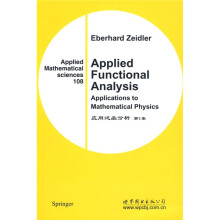Preface
Prologue
Contents of AMS Volume 109
1 Banach Spaces and Fixed-Point Theorems
1.1 Linear Spaces and Dimension
1.2 Normed Spaces and Convergence
1.3 Banach Spaces and the Cauchy Convergence Criterion
1.4 Open and Closed Sets
1.5 Operators
1.6 The Banach Fixed-Point Theorem and the Iteration Method
1.7 Applications to Integral Equations
1.8 Applications to Ordinary Differential Equations
1.9 Continuity
1.10 Convexity
1.11 Compactness
1.12 Finite-Dimensional Banach Spaces and Equivalent Norms
1.13 The Minkowski Functional and Homeomorphisms
1.14 The Brouwer Fixed-Point Theorem
1.15 The Schauder Fixed-Point Theorem
1.16 Applications to Integral Equations
1.17 Applications to Ordinary Differential Equations
1.18 The Leray-Schauder Principle and a priori Estimates
1.19 Sub-and Supersolutions, and the Iteration Method in Ordered Banach Spaces
1.20 Linear Operators
1.21 The Dual Space
1.22 Infinite Series in Normed Spaces
1.23 Banach Algebras and Operator Functions
1.24 Applications to Linear Differential Equations in Banach Spaces
1.25 Applications to the Spectrum
1.26 Density and Approximation
1.27 Summary of Important Notions
2 Hilbert Spaces, Orthogonality, and the Dirichlet
Principle
2.1 Hilbert Spaces
2.2 Standard Examples
2.3 Bilinear Forms
2.4 The Main Theorem on Quadratic Variational Problems
2.5 The Functional Analytic Justification of the Dirichlet Principle
2.6 The Convergence of the Ritz Method for Quadratic Variational Problems
2.7 Applications to Boundary-Value Problems, the Method of Finite Elements, and Elasticity
2.8 Generalized Functions and Linear Functionals
2.9 Orthogonal Projection
2.10 Linear Functionals and the Riesz Theorem
2.11 The Duality Map
2.12 Duality for Quadratic Variational Problems
2.13 The Linear Orthogonality Principle
2.14 Nonlinear Monotone Operators
2.15 Applications to the Nonlinear Lax-Milgram Theorem and the Nonlinear Orthogonality Principle
3 Hilbert Spaces and Generalized Fourier Series
3.1 Orthonormal Series
3.2 Applications to Classical Fourier Series
3.3 The Schmidt Orthogonalization Method
3.4 Applications to Polynomials
3.5 Unitary Operators
3.6 The Extension Principle
3.7 Applications to the Fourier Transformation
3.8 The Fourier Transform of Tempered Generalized Functions
4 Eigenvalue Problems for Linear Compact Symmetric Operators
4.1 Symmetric Operators
4.2 The Hilbert-Schmidt Theory
4.3 The Fredholm Alternative
4.4 Applications to Integral Equations
4.5 Applications to Boundary-Eigenvalue Value Problems
5 Self-Adjoint Operators, the Priedrichs Extension and the Partial Differential Equations of Mathematical
Physics
5.1 Extensions and Embeddings
5.2 Self-Adjoint Operators
5.3 The Energetic Space
5.4 The Energetic Extension
5.5 The Friedrichs Extension of Symmetric Operators
5.6 Applications to Boundary-Eigenvalue Problems for the Laplace Equation
5.7 The Poincar6 Inequality and Rellichs Compactness Theorem
5.8 Functions of Self-Adjoint Operators
5.9 Semigroups, One-Parameter Groups, and Their Physical Relevance
5.10 Applications to the Heat Equation
5.11 Applications to the Wave Equation
5.12 Applications to the Vibrating String and the Fourier Method
5.13 Applications to the SchrSdinger Equation
5.14 Applications to Quantum Mechanics
5.15 Generalized Eigenfunctions
5.16 Trace Class Operators
5.17 Applications to Quantum Statistics
5.18 C*-Algebras and the Algebraic Approach to Quantum Statistics
5.19 The Fock Space in Quantum Field Theory and the Pauli Principle
5.20 A Look at Scattering Theory
5.21 The Language of Physicists in Quantum Physics and the Justification of the Dirac Calculus
5.22 The Euclidean Strategy in Quantum Physics
5.23 Applications to Feynmans Path Integral
5.24 The Importance of the Propagator in Quantum Physics
5.25 A Look at Solitons and Inverse Scattering Theory
Epilogue
Appendix
References
Hints for Further Reading
List of Symbols
List of Theorems
List of the Most Important Definitions
Subject Index

 缺书网
缺书网 扫码进群
扫码进群






